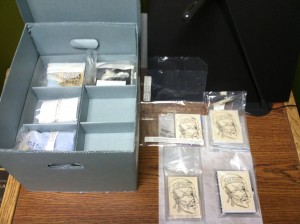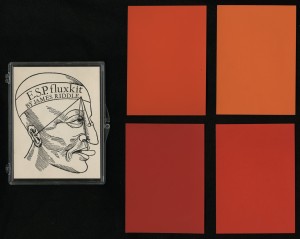James Riddle, creator of the E.S.P. fluxkit, is represented in the collection by 4 E.S.P. fluxkits.
1) clear box; colored cards visible
2) clear box; colored cards visible
3) white box; contents not visible
4) box with white top, black bottom; contents not visible
Not physically identical, but conceptually, yes, the idea goes across the board. The directions (when available) state that one is to run one’s fingers lightly over the cards while blindfolded in an effort to distinguish the colors from one another. In attempting to give a digital sense of the physical collection here at the University of Iowa, Which Riddle gets scanned? I ask the boxes: who wants to go? I wait for them to speak. Nope. Nothing. This moment is E.S.P. free. I pay more mind to the containers for each box, which has the most identifying ephemera? Which has been most attentively labeled and wrapped?
Somewhere I read that they should contain 10 cards. Well, that’s not quite the reality. Two boxes contain 6 cards and instructions, one contains 9 cards, the last contains 13 cards PLUS instructions. And there we have it. I won’t presume to redistribute the cards evenly but I will give the best representation of the color spectrum Riddle wanted to pose in the E.S.P. fluxkits. Or was it the color spectrum he was really getting at?
Again we are posed with more questions than answers, but the collection only becomes more intriguing.


